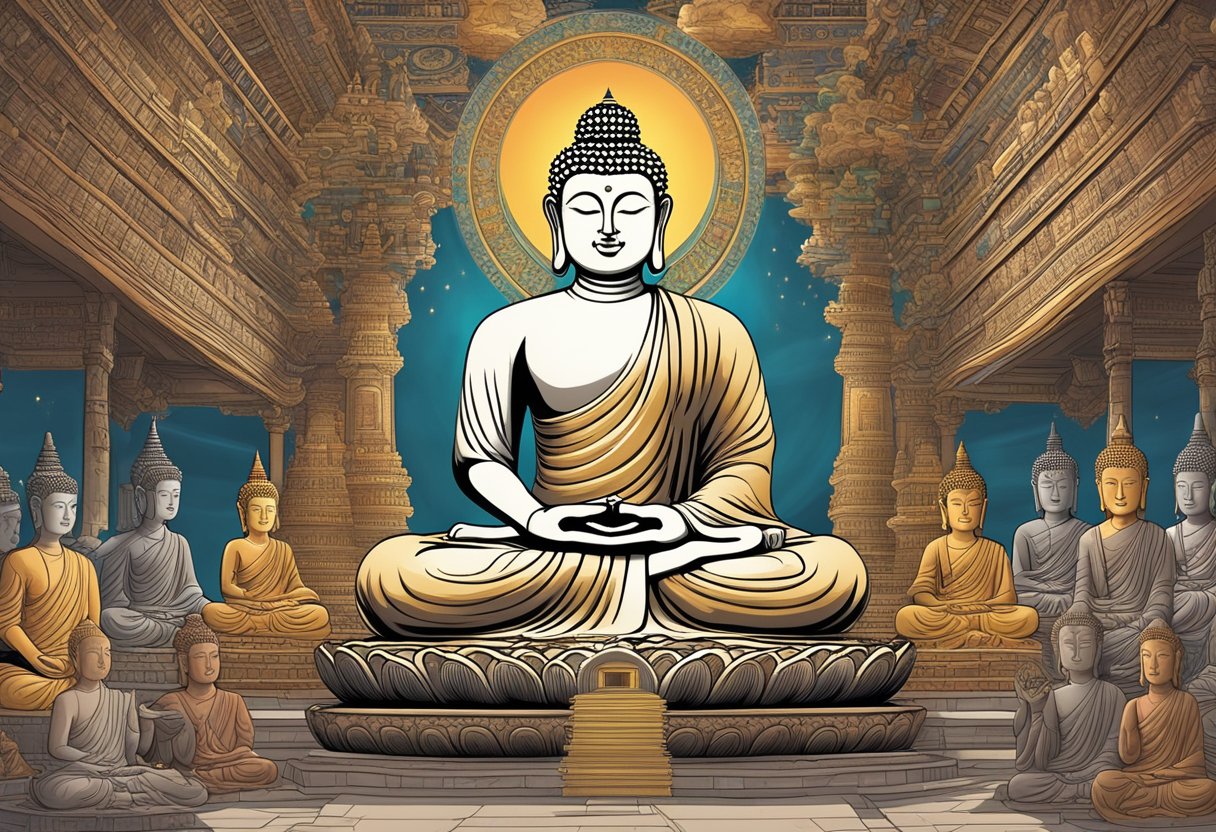Types Of Buddhism
Buddhism is a religion and philosophy that originated in ancient India and has since spread across the world. There are different types of Buddhism, each with its unique approach and style to overcoming suffering and realizing one’s potentials. Despite their differences, all forms of Buddhism share the essential teachings of Buddha and the essential features of mindfulness, meditation, logic, and debate.
The three main branches of Buddhism are Theravada, Mahayana, and Vajrayana. Theravada Buddhism is the oldest and most traditional form of Buddhism, while Mahayana and Vajrayana are more recent developments. Each branch has different beliefs, practices, and traditions and can influence one’s spiritual journey in different ways.
Understanding the different types of Buddhism can help one gain a deeper appreciation of this ancient religion and its impact on the world. By exploring the historical context, major schools, core philosophies, and practices of Buddhism, one can gain a better understanding of its cultural impact and modern developments.
Historical Context and Origins

Buddhism is a religion that originated in ancient India more than 2,500 years ago. It was founded by Siddhartha Gautama, also known as the Buddha. The teachings of the Buddha have spread throughout the world and have been divided into various schools of thought, including Theravada, Mahayana, and Vajrayana.
Ancient India and the Buddha
The Buddha was born in the 6th century BCE in Lumbini, which is now part of Nepal. He was a prince who left his luxurious life to seek enlightenment. After many years of meditation and contemplation, he achieved enlightenment under a Bodhi tree in Bodh Gaya, India.
The Buddha’s teachings revolved around the Four Noble Truths, which state that suffering is inherent in life, that suffering arises from craving and attachment, that suffering can be overcome, and that the path to the cessation of suffering is the Eightfold Path.
Spread of Buddhism in Asia
Buddhism spread throughout Asia, starting with the Mauryan Empire in India. Emperor Ashoka was a key figure in the spread of Buddhism, as he promoted the religion throughout his empire. From India, Buddhism spread to Southeast Asia, East Asia, Central Asia, China, Tibet, and beyond.
Theravada Buddhism is the oldest school of Buddhism and is still practiced in Sri Lanka and Southeast Asia. Mahayana Buddhism developed in China and spread to Korea, Japan, and Vietnam. Vajrayana Buddhism is practiced in Tibet and Mongolia.
Buddhism has had a significant impact on the cultures and societies of Asia. It has influenced art, literature, philosophy, and politics. Today, Buddhism is a major world religion with millions of followers around the globe.
Major Schools of Buddhism
Buddhism is a complex and diverse religion with many different schools, traditions, and practices. In contemporary Buddhist studies, modern Buddhism is often divided into three major branches, traditions, or categories: Theravada, Mahayana, and Vajrayana. Each of these schools has its own unique characteristics and practices.
Theravada Buddhism
Theravada Buddhism, also known as the “Doctrine of the Elders,” is considered the most orthodox form of Buddhism. It is the dominant form of Buddhism in Sri Lanka, Thailand, Cambodia, Myanmar (Burma), and Laos. The Theravada tradition emphasizes the importance of individual enlightenment and the attainment of nirvana through meditation and the study of the Pali Canon, which is the oldest surviving Buddhist text written in the Pali language.
Mahayana Buddhism
Mahayana Buddhism, also known as the “Great Vehicle,” is the dominant form of Buddhism in China, Japan, Korea, Tibet, Mongolia, Nepal, and most of Vietnam. The Mahayana tradition emphasizes the importance of compassion and the attainment of enlightenment for the benefit of all sentient beings. The Mahayana tradition also places greater emphasis on the use of Sanskrit as a language of religious texts and ritual.
Vajrayana Buddhism
Vajrayana Buddhism, also known as the “Diamond Vehicle,” is the dominant form of Buddhism in Bhutan and parts of Tibet. The Vajrayana tradition emphasizes the use of tantric practices and rituals to achieve enlightenment quickly. Tantric practices involve the use of mantras, mudras, and mandalas to transform ordinary experiences into spiritual ones. The Vajrayana tradition also emphasizes the importance of a guru or spiritual teacher in guiding the practitioner towards enlightenment.
In conclusion, the three major schools of Buddhism, Theravada, Mahayana, and Vajrayana, each have their own unique characteristics and practices. The Theravada tradition emphasizes individual enlightenment and the study of the Pali Canon, while the Mahayana tradition emphasizes compassion and the use of Sanskrit. The Vajrayana tradition emphasizes the use of tantric practices and the importance of a guru or spiritual teacher.
Core Philosophies and Teachings
Buddhism is a religion that is based on the teachings of the Buddha, who was a spiritual leader and teacher that lived in India around 2,500 years ago. His teachings have been passed down through the generations and have been divided into different branches, each with its own set of beliefs and practices. In this section, we will explore the core philosophies and teachings of Buddhism.
Four Noble Truths and Noble Eightfold Path
The Four Noble Truths and the Noble Eightfold Path are the foundation of Buddhist philosophy. The Four Noble Truths are:
- The truth of suffering (dukkha)
- The truth of the cause of suffering (samudaya)
- The truth of the cessation of suffering (nirodha)
- The truth of the path leading to the cessation of suffering (magga)
The Noble Eightfold Path is a set of guidelines that help practitioners achieve enlightenment and end their suffering. It includes:
- Right understanding
- Right intention
- Right speech
- Right action
- Right livelihood
- Right effort
- Right mindfulness
- Right concentration
Concept of Enlightenment and Nirvana
Enlightenment is the ultimate goal of Buddhism. It is the state of being that is achieved when one has reached a complete understanding of the nature of reality. Nirvana is the state of ultimate enlightenment, where one has transcended all suffering and has achieved a state of perfect peace and happiness.
Bodhisattva Ideal and Compassion
The Bodhisattva ideal is central to Mahayana Buddhism. It is the idea that one should strive to become a Bodhisattva, a being that is dedicated to helping others achieve enlightenment. Compassion is a key component of the Bodhisattva ideal, as it is through compassion that one can truly help others.
In Buddhism, wisdom and compassion are seen as two sides of the same coin. Wisdom is the understanding of the true nature of reality, while compassion is the desire to relieve the suffering of others.
Overall, the core philosophies and teachings of Buddhism emphasize the importance of truth, wisdom, compassion, and the pursuit of enlightenment. By following the Noble Eightfold Path and striving to become a Bodhisattva, practitioners can achieve a state of perfect peace and happiness.
Practices and Rituals
Buddhism is a religion that places great emphasis on personal spiritual development. Practices and rituals play an important role in Buddhism, as they help to cultivate inner peace and wisdom. In this section, we will explore some of the most common practices and rituals in Buddhism.
Meditation and Mindfulness
Meditation is a core practice in Buddhism, and it involves training the mind to focus on the present moment. This practice helps to develop mindfulness, which is the ability to be fully present and aware of one’s thoughts, feelings, and surroundings. There are many different types of meditation, including breath meditation, loving-kindness meditation, and insight meditation.
Chanting and Mantras
Chanting is another common practice in Buddhism, and it involves repeating a mantra or sacred phrase. This practice helps to calm the mind and cultivate inner peace. Mantras are often used in conjunction with meditation, and they can help to focus the mind and deepen one’s spiritual practice.
Rituals and Ceremonies
Buddhism has a rich tradition of rituals and ceremonies, which are often used to mark important events in a person’s life. These rituals can include everything from simple daily offerings to elaborate ceremonies that involve chanting, meditation, and offerings to the Buddha. Monastic life is also an important aspect of Buddhism, and many rituals are performed by monks in monasteries.
In conclusion, practices and rituals are an integral part of Buddhism, and they play an important role in helping individuals cultivate inner peace and wisdom. Whether through meditation, chanting, or ritual ceremonies, these practices can help to deepen one’s spiritual practice and bring a sense of peace and tranquility to daily life.
Cultural Impact and Modern Developments
Buddhism has had a significant cultural impact on the world, particularly in the West, where it has gained a large following. The religion has been able to adapt to modern times, incorporating new ideas and technologies while still maintaining its core principles.
Buddhism in the West
Buddhism has become increasingly popular in the West, with many people turning to the religion as a way to find inner peace and meaning in their lives. The Dalai Lama, the spiritual leader of Tibetan Buddhism, has been instrumental in bringing the religion to the West, traveling extensively and giving talks and teachings to audiences around the world.
One of the most significant developments in modern Buddhism has been the rise of Zen Buddhism in the West. Zen emphasizes the importance of meditation and mindfulness, and has become popular among people of all backgrounds and beliefs.
Interactions with Other Religions
Buddhism has also had interactions with other religions, particularly Hinduism. Many of the concepts and practices of Buddhism are similar to those of Hinduism, and the two religions have influenced each other over the centuries.
The Buddhist canon, particularly the Pali Canon, contains many of the earliest Buddhist texts and scriptures, and has been a significant influence on the development of the religion. Tibetan Buddhism, which incorporates elements of both Buddhism and the indigenous Bon religion, has also had a significant impact on the development of the religion.
Overall, Buddhism has been able to adapt to modern times while still maintaining its core principles and teachings. Its impact on culture and society continues to be felt around the world, and it remains a powerful force for spiritual growth and enlightenment.



